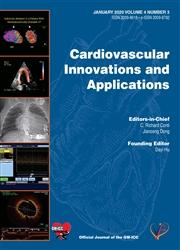Combination of Neutrophil Count and Gensini Score as a Prognostic Marker in Patients with ACS and Uncontrolled T2DM Undergoing PCI
IF 0.9
4区 医学
Q4 CARDIAC & CARDIOVASCULAR SYSTEMS
引用次数: 0
Abstract
Background: Several biomarkers have been studied as prognostic indicators among people with diabetes and coronary artery disease (CAD). The purpose of this study was to determine the prognostic value of neutrophil counts and the Gensini score in patients with diabetes and ACS undergoing percutaneous coronary intervention (PCI). Methods: A total of 694 people with ACS and T2DM who simultaneously had elevated HBA1c received PCI. Spearman rank correlation estimates were used for correlation evaluation. Multivariate Cox regression and Kaplan-Meier analysis were used to identify characteristics associated with major adverse cardiovascular and cerebrovascular events (MACCEs) and patient survival. The effects of single- and multi-factor indices on MACCEs were evaluated through receiver operating characteristic curve analysis. Results: The Gensini score and neutrophil count significantly differed between the MACCE and non-MACCE groups among patients receiving PCI who had concomitant ACS and T2DM with elevated HBA1c (P<0.001). The Gensini score and neutrophil count were strongly associated with MACCEs (log-rank, P<0.001). The Gensini score and neutrophil count, alone or in combination, were predictors of MACCEs, according to multivariate Cox regression analysis (adjusted hazard ratio [HR], 1.005; 95% confidence interval [CI], 1.002–1.008; P=0.002; adjusted HR, 1.512; 95% CI, 1.005–2.274; P=0.047, respectively). The Gensini score was strongly associated with neutrophil count (variance inflation factor ≥ 5). Area under the curve analysis revealed that the combination of multivariate factors predicted the occurrence of MACCEs better than any single variable. Conclusion: In patients with T2DM and ACS with elevated HBA1c who underwent PCI, both the Gensini score and neutrophil count were independent predictors of outcomes. The combination of both predictors has a higher predictability.中性粒细胞计数和Gensini评分联合作为ACS和未控制T2DM患者行PCI的预后指标
背景:已经研究了几种生物标志物作为糖尿病和冠心病(CAD)患者的预后指标。本研究的目的是确定中性粒细胞计数和Gensini评分在经皮冠状动脉介入治疗(PCI)的糖尿病和ACS患者中的预后价值。方法:694例同时HBA1c升高的ACS和T2DM患者接受PCI治疗。相关性评价采用Spearman秩相关估计。多变量Cox回归和Kaplan-Meier分析用于确定与主要不良心脑血管事件(MACCEs)和患者生存相关的特征。通过受试者工作特征曲线分析,评价单因素和多因素指标对MACCEs的影响。结果:在合并ACS和T2DM并HBA1c升高的PCI患者中,MACCE组和非MACCE组Gensini评分和中性粒细胞计数差异有统计学意义(P<0.001)。Gensini评分和中性粒细胞计数与MACCEs密切相关(log-rank, P<0.001)。根据多因素Cox回归分析,Gensini评分和中性粒细胞计数单独或联合是MACCEs的预测因子(校正风险比[HR], 1.005;95%置信区间[CI], 1.002-1.008;P = 0.002;调整后的HR为1.512;95% ci, 1.005-2.274;分别为P = 0.047)。Gensini评分与中性粒细胞计数密切相关(方差膨胀因子≥5)。曲线下面积分析显示,多因素联合预测MACCEs的发生优于任何单一变量。结论:在接受PCI治疗的T2DM和ACS合并HBA1c升高的患者中,Gensini评分和中性粒细胞计数是预后的独立预测因子。两种预测因子的组合具有更高的可预测性。
本文章由计算机程序翻译,如有差异,请以英文原文为准。
求助全文
约1分钟内获得全文
求助全文
来源期刊

Cardiovascular Innovations and Applications
CARDIAC & CARDIOVASCULAR SYSTEMS-
CiteScore
0.80
自引率
20.00%
发文量
222
 求助内容:
求助内容: 应助结果提醒方式:
应助结果提醒方式:


